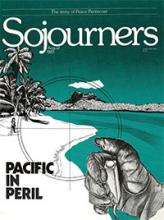In Pasadena, at the recent evangelical Conference on Church and Peacemaking in a Nuclear Age, I was reminded of a conversation that took place in 1977 between Wes Granberg-Michaelson, Gordon Cosby, Richard Barnet, Mernie King, and myself. We asked ourselves whether the threat of nuclear war might become a galvanizing issue in the churches.
Public actions opposing nuclear weapons had already begun in 1976 and 1977, largely undertaken by small Christian communities and often including nonviolent civil disobedience. The first Sojourners special issue on nuclear war came out in February, 1977.
In retrospect, I believe our biblical paradigm was Ezekiel 33, in which the watchman on the wall who saw the sword coming was to warn the people. But because there was little or no public awareness at that time about the nuclear threat, at first these actions seemed strange, extreme, foolish, hard to understand. Then slowly the danger of nuclear war began to make itself known in the public consciousness. A number of factors contributed to this awareness.
First, the government's strategic nuclear policy shifted from deterrence to counterforce and first strike. The first signs of this change appeared in the Carter administration with the statements of then Secretary of Defense James Schlesinger. The new policy culminated in Carter's Presidential Directive 59, which publicly articulated the doctrine of first strike willingness and subsequent reliance on counterforce weapons.
A second factor was the new military buildup that began during the Carter years (contrary to what people think) and was greatly accelerated to unprecedented levels with the onset of the Reagan administration. A whole new generation of nuclear weapons was brought on line for research and development, production, and deployment: the MX, cruise, and Pershing II missiles, the Trident submarine and missiles, and the B-l bomber.
Read the Full Article

